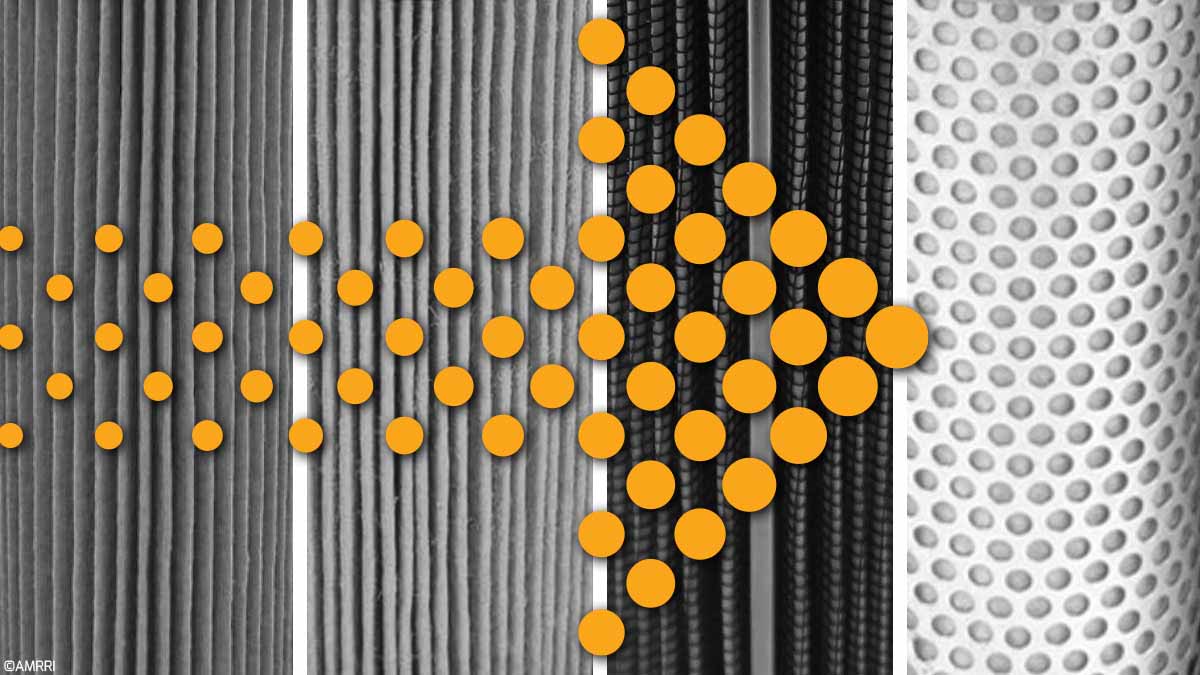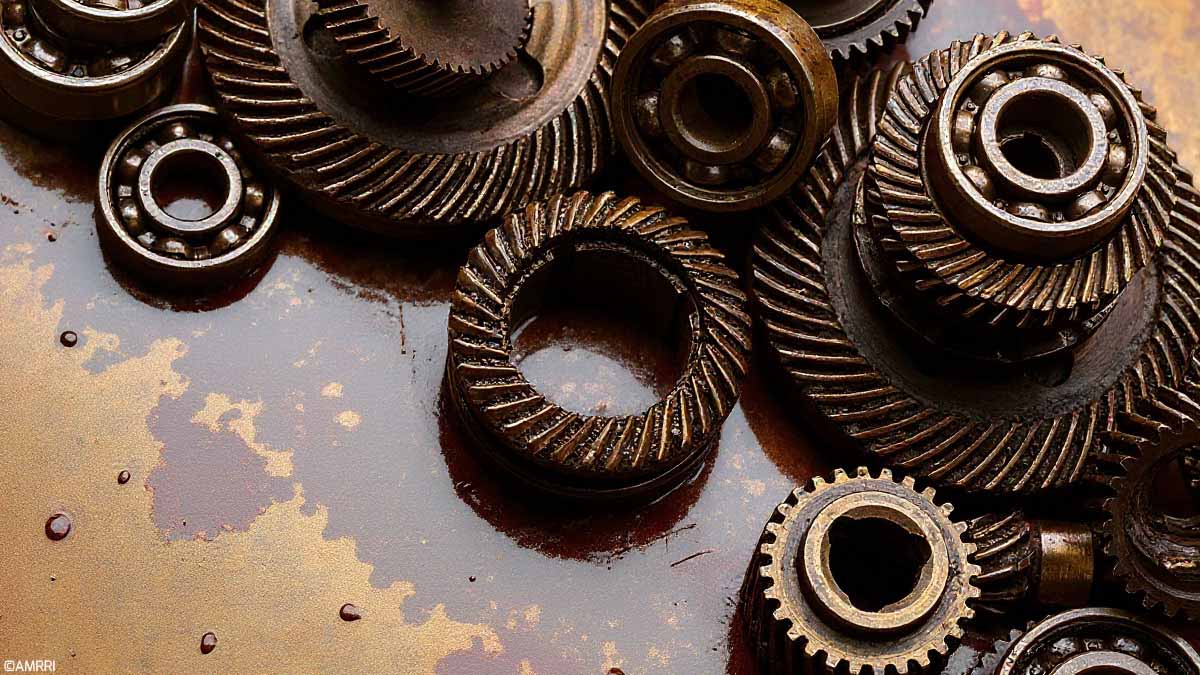In December 2015, the Paris Agreement came to life at the Paris Climate Conference (COP21). This agreement is the first-ever universal, legally binding global climate change agreement and was adopted by consensus by all members of the United Nations Framework Convention on Climate Change (UNFCCC). The Paris agreement outlines the global framework to limit global warming well below 2°C.
Currently, 197 countries have agreed to work towards reaching net carbon neutrality by 2050. Ideally, this should keep the temperatures below 1.5°C by 2100. However, as per the Global Climate Action Tracker released in May 2021, the current policies estimate that the levels can increase to a maximum of 3.9°C with a minimum of 2.1°C. With the pledges and targets, it is hoped to achieve an average of 2.4°C, as seen in Figure 1 below.
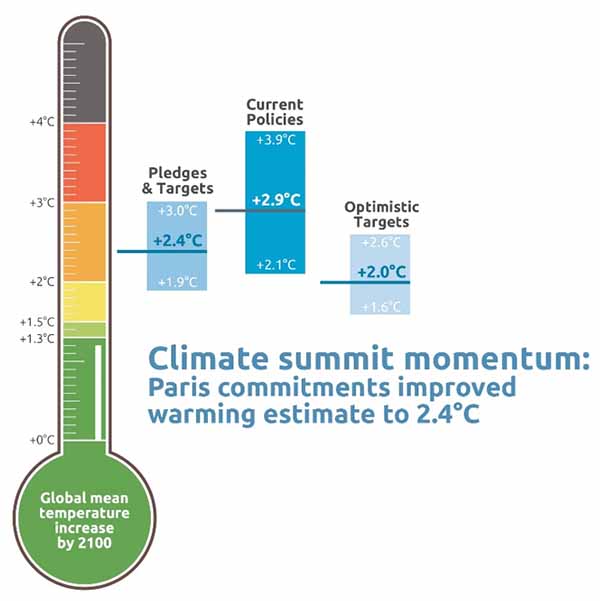
Figure 1: The Climate Action Tracker thermometer showing projected impact on temperature increases by 2100 based on Pledges and Targets, Current Policies and the Optimistic Targets scenarios. (Source: Climate Action Tracker, May 2021 Update).
What can the difference of 1°C indicate?
As per Vitra Global, the last time the global average temperature was 2°C warmer, the average sea level was over 6 meters higher than today. Thus, with a 3°C rise, cities such as Miami, Shanghai, Osaka, or Rio do Janeiro could sink underwater. This can potentially force 275 million people worldwide to relocate to escape flooding. Figure 2 shows the impact of the Paris Agreement on the estimated global temperatures from the Global Climate Tracker.
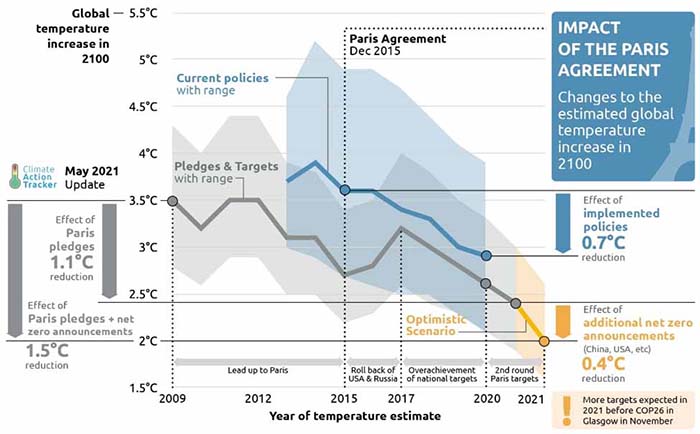
Figure 2: Impact of the Paris Agreement on the estimated global temperature increase in 2100. Figure shows the estimates of the Climate Action Tracker from 2009-2021 for its “pledges and targets” and “current policies” scenarios. Source: https://climateactiontracker.org/documents/853/CAT_2021-05-04_Briefing_Global-Update_Climate-Summit-Momentum.pdf
What is the role of the Industrial sector in Decarbonization?
Decarbonization is the process of reducing greenhouse gas (GHG) emissions. The most critical gases which contribute to the GHG effect are Carbon Dioxide (CO2), Methane (CH4), Nitrous Oxide (N2O), and fluorinated gases. In the United States, CO2 emissions represent over 80% of U.S. manufacturing energy-related GHG emissions, as per the United States Department of Energy.
In September 2022, the United States Department of Energy released its Industrial Decarbonization Roadmap (DOE/EE-2635). It details Decarbonization pathways to Net-Zero Emissions by 2050 for Five Energy Intensive Industrial Subsectors: Chemicals, Refining, Iron & Steel, Food & Beverage, and Cement & Lime. Figure 3 shows a breakdown of the percentage of Industrial MMT (Million Metric Tons) CO2 per sector.
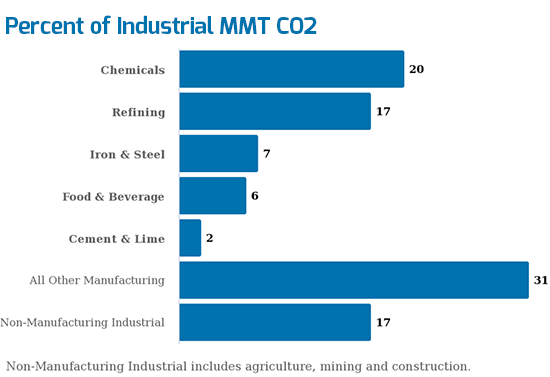
Figure 3: Percent of Industrial MMT CO2. Data Source: “Annual Energy Outlook 2021 with Projections to 2050,” U.S. Energy Information Administration, Feb. 3, 2021. Note: The roadmap analysis covered only part of the chemicals (ammonia, methanol, ethylene, and BTX)
Overall, industry represents 30% of U.S. energy-related CO2 emissions, which translates to 1360 Million Metric tons of CO2 (based on stats from 2020). The five highest sectors in which decarbonization can have the most significant impact account for 51% of energy-related CO2 emissions in the U.S. industrial sector. This also represents 15% of the U.S. economy-wide total CO2 emissions.
Four key technological pillars can significantly reduce emissions for the five subsectors identified above. These crosscutting decarbonization pillars are; Energy efficiency, Industrial Electrification, Low-Carbon Fuels, Feedstocks and Energy Sources (LCFFES), and Carbon Capture, utilization, and storage (CCUS), as shown in figure 4 below.

Figure 4: Strategies for Decarbonizing U.S. Industries. Source: https://www.energy.gov/eere/doe-industrial-decarbonization-roadmap
How can sustainable lubrication help?
Based on the information seen thus far, it can be concluded that the industrial sector accounts for a fair amount of GHG emissions. In most of these industries, lubricants are used in small and large quantities. Lubrication can significantly impact the overall efficiency of a machine if the proper lubricant is being used while performing its function of reducing the coefficient of friction. The lubricant can also affect the energy efficiency of the equipment. In most cases, particular types of lubricants have shown considerably reduced power consumption. As shown in figure 5, Industrial Energy consumption contributes to 33% according to the U.S. DOE’s R&D Roadmap.
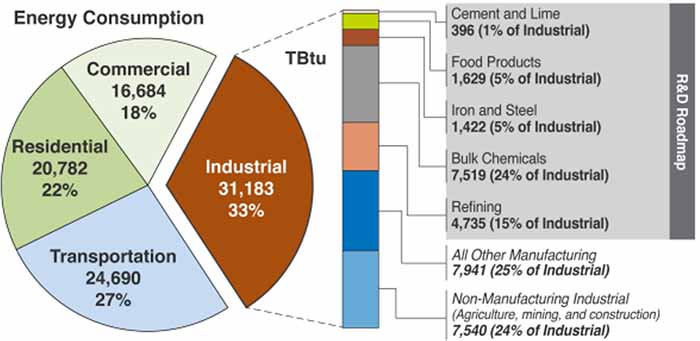
Figure 5: U.S. primary energy consumption by end use sector (left pie chart) and a breakout by industrial subsector (right stacked chart) in 2020. Offsite electricity losses (for the power generation sector) are allocated to end use industries. Source: U.S. DOE Industrial Decarbonization Roadmap.
Significant efforts are being made to increase the use of energy-efficient lubricants. Two roadblocks to widespread adoption include cost and the challenge of quantifying measurable improvements. Energy-efficient lubricants typically cost more because they are made of tailored synthesized chemicals rather than straight hydrocarbon base oils. Generally, users are reluctant to purchase more expensive products unless there is demonstrable value.
One example is the use of multigrade hydraulic oils in industrial applications. Shear-stable polyalkylmethacrylate polymers are excellent viscosity index improvers, and multiple studies have demonstrated energy efficiency gains of 5-15% compared to monograde hydraulic oils. However, in most hydraulic applications, measuring these improvements is challenging without sophisticated equipment.
Another example exists in the turbine oil space. Mobil recently introduced a new turbine oil formulation that is 18cSt at 40oC rather than a standard ISO 32 VG, which is 32cSt at 40oC. This was designed to meet GE’s new specification, GEK 121603. Mobil developed a mathematical model to measure efficiency improvements and verified the measurements in test rigs and full-scale gas turbines. Compared to a standard ISO 32 VG formulation, the new formulation increases overall turbine efficiency by 0.09% due to reductions in bearing frictional energy loss. This slight improvement in energy efficiency can translate to tens of thousands of dollars of fuel savings and a reduction of over 400 tons of CO2e annually. Measuring these energy efficiency improvements in the field remains challenging, but bearing and lube oil drain temperature reductions at similar load and ambient conditions can confirm these improvements.
The road to lubricant decarbonization does not just lay with energy efficiency improvements. Significant efforts can be made to lower GHG emissions by using more sustainable lubricants and implementing sustainable lubrication practices. This approach often provides cost savings, and the environmental benefit can be quantified. There are three critical activities for more sustainable lubrication include:
- Extending drain intervals
- Implementing sustainable lubrication practices
- Using lubricants formulated from renewable sources
Each of these practices allows accurate measurement of the environmental benefit using Life Cycle Assessment (LCA). Although LCA is a well-documented practice defined in ISO 14040, there are still areas of interpretation in performing LCAs on lubricants. To provide more clarity on performing LCAs, the American Petroleum Institute (API) is creating a technical report entitled “Lubricants Life Cycle Assessment and Carbon Footprinting – Methodology and Best Practice.” Although this report is still in its draft form, its publication will improve the accuracy and consistency of performing LCAs on lubricants.
Fill4Life™ Lubricants – one pathway toward sustainable lubrication
Over 50 billion liters of lubricants are sold annually. Approximately half of this volume is formulated into engine oils, and the other half is formulated into industrial lubricants. If only 1% of the industrial oils doubled their oil drain interval, this would equate to a reduction of over one million metric tons of CO2e per year.
This is one of the reasons why Fluitec has developed the concept of Fill4Life lubrication. This practice converts lubricants from a consumable into an asset. Like any other asset at an operating plant, the lubricant’s life is optimized rather than treated like a consumable. Actively removing dead oil molecules while replenishing the lubricant with fresh additive components allows the oil’s life to be significantly extended. Fluitec’s Solvancer® family of technologies has been formulated to optimize oil life and performance. For example, DECON AO was developed to replenish the sacrificial antioxidants in turbine and compressor oils. Long-term field studies have demonstrated DECON AO’s ability to more than double the life of in-service lubricants. The range of Solvancer technologies, including the world’s first Fill4Life turbine oil, can be seen in Figure 6.
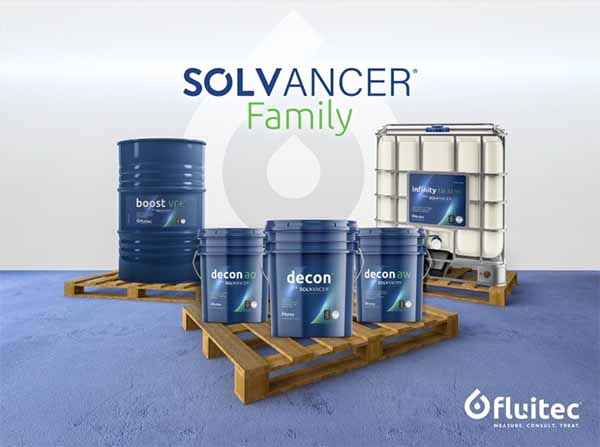
Figure 6: The Solvancer® family from Fluitec
The oil must be kept clean and free from moisture while maintaining a healthy balance of additives to increase its lifespan. Fluitec’s Electrophysical Separation Process (ESP) VITA units can assist in removing varnish-related deposits from the oil. Furthermore, ESP removes some of the free radicals in the oil, which consume antioxidants and can increase the life of the oil by >50%.
The Solar Impulse Foundation has independently verified these solutions, resulting in the Fill4Life solution being granted the exclusive Efficiency Solution award in 2019. Solar Impulse Foundation created this award for technologies that simultaneously address climate change while enabling economic growth. An independent Life Cycle Assessment demonstrated a reduction of >90% GHGs with Fluitec’s Fill4Life solution. In addition, average cost savings are over 60%. Fill4Life is at the intersection of sustainability and economics and represents a positive movement in the energy industry’s decarbonization efforts.
Overall, the drive toward lubricant decarbonization will only begin when there is a change toward more sustainable practices. This can be initiated by increased awareness of the environmental impacts of the various industries on the planet. The pathway toward keeping the temperatures below 1.5°C by 2100 can only be achieved if we all work together to help reduce our GHG emissions.








